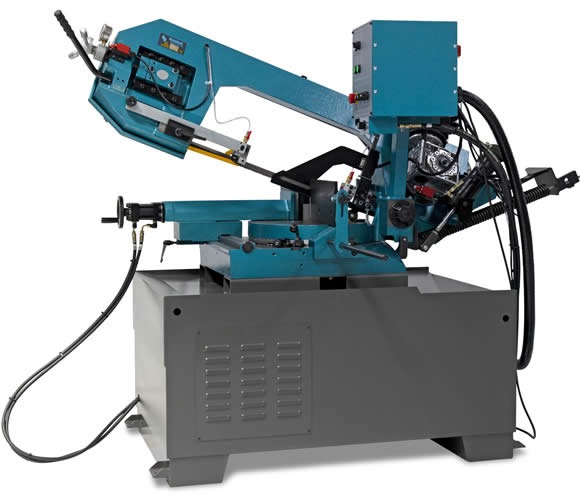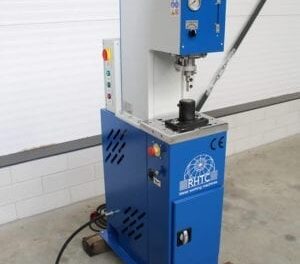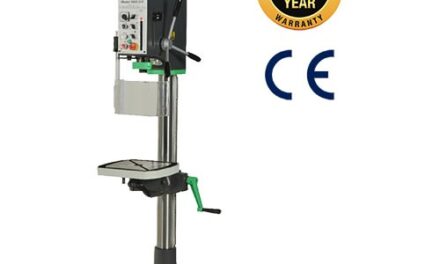At Workshop Press, we know that selecting the right bandsaw can make a significant impact on efficiency, precision, and productivity in metalworking and fabrication. Whether you’re operating a large industrial facility or a small workshop, choosing between a horizontal vs vertical bandsaw is crucial for ensuring optimal cutting performance.
Each type of bandsaw has distinct advantages suited for different cutting applications. In this guide, we compare horizontal and vertical bandsaws, highlight the best type of bandsaw for metal cutting, and outline the key benefits of each to help you make an informed decision.
Understanding Horizontal and Vertical Bandsaws
Before we compare their advantages, let’s define how each type of bandsaw operates.
What is a Horizontal Bandsaw?
A horizontal bandsaw features a blade positioned horizontally that moves downward to cut through metal. It is ideal for cutting long stock such as pipes, bars, and beams with precision and efficiency.
Key Features of Horizontal Bandsaws:
- Mounted on a sturdy frame with a downward-moving blade
- Uses gravity or hydraulic force for controlled cutting
- Equipped with automatic feeding systems for higher efficiency
- Designed for repetitive, high-volume cutting
What is a Vertical Bandsaw?
A vertical bandsaw has a blade positioned vertically, allowing for manual feeding of material into the cutting edge. This design makes it highly versatile, ideal for intricate cuts, curves, and contouring.
Key Features of Vertical Bandsaws:
- Fixed blade position with manual material guidance
- Best for cutting complex shapes, angles, and contours
- Suitable for beveling, resawing, and precision trimming
- Ideal for fabrication shops, maintenance facilities, and metalworking workshops
Now that we understand how each bandsaw works, let’s compare their advantages.
Advantages of Horizontal Bandsaws
1. Best for High-Volume, Straight Cuts
A horizontal bandsaw is the best type of bandsaw for metal cutting when your workshop requires high-volume production. Its automated cutting process ensures speed and accuracy, making it perfect for fabrication and manufacturing.
2. Consistent and Automatic Cutting
- Even Pressure Application: Uses gravity or hydraulic systems to apply uniform pressure, ensuring precise and repeatable cuts.
- Automatic Feeding Systems: Allows operators to multitask, improving workshop efficiency.
3. Reduces Operator Fatigue
- Minimal Manual Effort: The blade moves automatically through the material, reducing physical strain on the operator.
- Less Supervision Needed: Ideal for long production runs where efficiency matters.
4. Increased Blade Longevity
- Even Cutting Pressure: Extends the life of the blade, reducing maintenance costs and machine downtime.
5. Ideal for Cutting Large Metal Stock
Perfect for cutting pipes, beams, and bars with minimal manual effort.
Ensures straight, clean cuts in high-strength materials.
Choose a Horizontal Bandsaw for:
- High-volume, repetitive cuts
- Cutting large metal stock
- Automatic and consistent production
Vertical Bandsaw Benefits
1. Ideal for Custom, Intricate Cuts
A vertical bandsaw is the best type of bandsaw for metal cutting when you need precision, flexibility, and control. It is commonly used for curves, irregular shapes, and contour cutting.
2. Versatile for Various Applications
- Suitable for beveling, resawing, trimming, and fabrication.
- Found in metalworking shops, maintenance workshops, and repair facilities.
3. Greater Operator Control
- Hands-On Operation: The operator guides the workpiece, allowing for custom adjustments.
- Fine Detail Work: Perfect for prototype fabrication and artistic metalwork.
4. Space-Saving Design
Compact footprint, making it ideal for smaller workshops.
5. Works with Multiple Materials
Cuts metals, plastics, composites, and even wood, making it an extremely versatile tool.
Choose a Vertical Bandsaw for:
- Cutting custom shapes and angles
- Fine-detail and precision cutting
- Space-saving workshop setups
Horizontal vs Vertical Bandsaw Comparison: Which One is Right for You?
| Feature | Horizontal Bandsaw | Vertical Bandsaw |
|---|---|---|
| Cutting Motion | Downward (automatic feed) | Manual feed (operator-guided) |
| Best for | Straight cuts, large stock | Custom cuts, intricate designs |
| Material Compatibility | Bars, pipes, beams | Sheet metal, irregular shapes |
| Production Efficiency | High-volume, repetitive | Low-volume, custom work |
| Space Requirement | Larger footprint | Compact, space-saving |
| Operator Involvement | Minimal (automatic cutting) | High (manual control) |
Choosing the Best Type of Bandsaw for Metal Cutting
When to Choose a Horizontal Bandsaw
- You need high-volume, straight cuts through thick metal stock.
- Your operation requires automatic and repetitive cutting.
When to Choose a Vertical Bandsaw
- You need precision cutting for curves, angles, and detailed fabrication.
- Your workshop has limited space, and you need a compact cutting tool.
Considering Both?
For workshops handling both production cutting and custom fabrication, investing in both bandsaw types offers the most flexibility.
FAQs About Horizontal and Vertical Bandsaws
1. Which bandsaw is better for metal cutting?
Both horizontal and vertical bandsaws are excellent for metal cutting. The best choice depends on whether you need high-volume, straight cuts (horizontal) or custom, precision work (vertical).
2. Can a vertical bandsaw cut thick metal?
Yes, but a horizontal bandsaw is better suited for thick materials, while vertical bandsaws are ideal for shaping and contouring.
3. Are horizontal bandsaws faster than vertical bandsaws?
Yes. Horizontal bandsaws use automatic cutting mechanisms, making them faster for repetitive cutting than vertical bandsaws.
4. What materials can a vertical bandsaw cut?
Vertical bandsaws can cut metal, wood, plastic, and composite materials, making them a versatile workshop tool.
5. Which bandsaw should I buy for my workshop?
If your workshop focuses on high-volume, straight-line cuts, a horizontal bandsaw is best. If you need versatility and precision, a vertical bandsaw is the better choice.
Conclusion: Why Workshop Press is Your Best Choice for Bandsaws
At Workshop Press, we offer high-performance horizontal and vertical bandsaws for workshops, manufacturing facilities, and industrial applications.
Horizontal bandsaws excel in high-volume, straight-line cutting.
Vertical bandsaws provide precision, flexibility, and control.
Both types of bandsaws offer unique advantages depending on your specific cutting requirements.
If you’re looking for the perfect bandsaw for your workshop, Workshop Press has expert solutions to meet your needs.
Contact us today for expert advice on choosing the best bandsaw for your metal cutting applications!
To read the original article please see here





